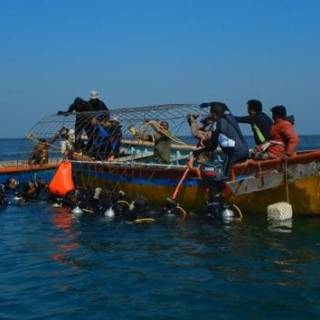Marine scientists from the Zoological Survey of India (ZSI) have installed the country's first solar-powered Biorock in the Gulf of Kutch off the Gujarat coast to regenerate endangered corals.
Biorocks are steel structures that installed on the seabed and are connected to a power source, such as solar panels, which stay afloat on the sea surface. Very low doses of electricity - less than 12 volts - are passed through the steel structure via cables.
"This triggers a chemical reaction in the seawater, similar to that of electrolysis. Minerals, mostly calcium carbonate (limestone), get deposited on the steel structure," Chowdula Satyanarayana, a ZSI coral scientist who is leading the project, said.
"This helps corals to regenerate and grow on the steel structures that could be of any shape from a simple arch to a statue or a motorcycle," he said.
Coral reefs are like underwater gardens and one of the most diverse ecosystems on earth providing food and shelter to millions of species.
They are under threat because of climate change-induced ocean acidification, pollution and human activities such as fishing among others.
"The first two Biorocks in India have been set up at the Gulf of Kutch on January 17. Calcium carbonate flakes started appearing on the structure the very next day, indicating the success of the project," ZSI's director Kailash Chandra said.
ZSI is taking the help of Thomas Goreau, a US-based coral expert who has helped more than 30 countries to set up bio-rocks. Goreau along with another expert, Wolf Hilbert, developed and patented the Biorock method,
The Gujarat forest department played a major role in the project and divers from the Indian Navy and Coast Guard also helped the researchers to lower the steel structures and install it on the sea bed last week.
"Scientists have collected fragments of broken corals from the sea bed and have tied them to the Biorock structures, which would help the corals to grow and form colonies. Initially, we plan to come up with 70 such colonies on the Biorocks," Goreau said.
With a base of limestone formed on steel structures and low doses of current supplied at regular intervals, the corals could grow nearly 20 times faster and have better chances of survival, experts claimed.
"It is just like giving oxygen to an athlete while he is running. With oxygen, he would be able to run faster and for a longer period. Similarly, it has been seen that providing small doses of electricity helps the corals to recuperate faster and survive longer," Satyanarayana said.
India has four major coral reefs areas in Andaman and Nicobar Islands, Lakshadweep, Gulf of Mannar and Gulf of Kutch. While the reefs in Andaman are considered the richest and most diverse, the ones in the Kutch area are the poorest.
Only 30% of the coral in the Kutch area is alive, albeit in a degraded condition.
There are around 600 species of hard corals found in India, all of which are highly protected and listed in Schedule 1 of the Wildlife Protection Act.
Around 50 of these are found in the Gulf of Kutch. They plan to first conserve the 50 species and then all the 600 species in such Biorocks.
Indian researchers have started the conservation project with four to five species of hard corals.
"While on one hand, Biorocks help to conserve corals, they also help to protect the shores from erosion, helps to promote tourism, and aquaculture among others. In Indonesia it has become a hub of underwater tourism," said Satyanarayana.
Biorocks have helped scientists in many countries to conserve and protect coral reefs. Pemuteran in Indonesia has the world's largest coral regeneration project where Biorock has been used.
